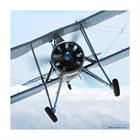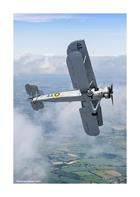HERITAGE GRANT RETURNS LEGENDARY SWORDFISH TO THE AIR!
Following an intensive weekend of successful test flights and display work-ups, the oldest surviving Fairey Swordfish Mk 1 bi-plane in the world, which saw active service with the Royal Navy in the Second World War, took to the skies again on 19 June 2015 for the first time since 2003.
Built in 1941 by Blackburn Aircraft at Sherburn-in-Elmet, Swordfish W5856 has undergone a lengthy rebuild over the last ten years and was finally saved for the nation and restored to full flying condition with the support of a £200,000 grant from the Peter Harrison Heritage Foundation.
“To see this venerable and historic aircraft flying again 74 years after she was built is incredible” said Rear Admiral Tom Cunningham, Chairman of the Fly Navy Heritage Trust. “It is a very emotional and moving sight and we are deeply indebted to Sir Peter Harrison. The aircraft is a national treasure – a real gem and Sir Peter’s generosity has brought history back to life!”
“We are also extremely grateful to BAE Systems for their longstanding support and expertise over many years,” continued Admiral Cunningham. “The aircraft was originally restored by BAE Systems in 1990 and gifted to the Royal Navy. When corrosion was found in the wing spars in 2003, BAE Systems stepped in again and skilled craftsmen and apprentices at Brough lovingly and painstakingly built a new set of wings.”
Although naval aircraft are designed to withstand the exacting demands of operating at sea, the Swordfish was not build with the expectation of still being airworthy over 70 years later and the restoration of Swordfish W5856 has been a meticulous and time consuming task.
Most of the work has been done by the small, dedicated team of engineers on the Royal Navy Historic Flight based at RNAS Yeovilton. “Restoring a beautiful old aircraft to full flying condition with very limited resources is a great achievement” said Howard Read, Chief Engineer on the Flight. “We are passionate about our heritage and it was a sheer joy to do.”
The aircraft’s Pegasus engine was completely overhauled and new pistons and cylinders had to be specially manufactured. W5856, which first flew on Trafalgar Day, 21 October 1941, has also been repainted in the colour scheme of 820 Naval Air Squadron when embarked in HMS Ark Royal during the attack on the Bismarck in the Northern Atlantic in the same year.
The Swordfish was a phenomenally successful early carrier borne combat aircraft and is of great historical significance to the Royal Navy. Between 1939 and 1945, Swordfish aircraft pursued the enemy, afloat and ashore, in every theatre of war, between the Atlantic and the Indian Ocean, the Equator and theArctic Circle.
The success of the Swordfish was its ability to fulfil many roles although it is best known for the part it played in defeating the U-boat threat in theBattleof the Atlantic, the triumph ofTarantoand for the attack on theBismarck.
Speaking of the challenges of getting W5856 back in the air, Lieutenant Commander Chris Götke AFC Royal Navy, Commanding Officer of the Royal Navy Historic Flight said “We have had to overcome many difficulties along the way but problem solving and finding innovative solutions is very much the ethos of the Fleet Air Arm. We could not have done it without the support of a great many people including BAE Systems, Cosworth, Deltair, the Rolls Royce Project Team, the airworthiness authorities, everyone at RNAS Yeovilton and of course Sir Peter Harrison. Without the heritage grant from Sir Peter’s foundation we would not be flying this magnificent aircraft today.”
Chris, who recently converted to the Swordfish, described the thrill of flying such an iconic and rare aircraft. “She is a 1930s design and the cockpit controls are in all manner of nooks and crannies! But what an absolute delight to fly! The theatrics of starting her up and taxying out are probably the trickiest part but once she is flying it is just amazing!”
“The engine has been running extremely smoothly and well. The Swordfish is renowned for its low-speed handling and she has a tight turning circle at slow speed, which was good for fighter evasion! But it is the open cockpit of course, that makes her unique. In the back there is no real seating so you can look over the side like a hot air balloon. It also looks fairly sedate from the ground but it is very noisy, windy and cold in the air! I feel very privileged to be able to fly the aircraft and when you think of the atrocious conditions endured by her crews in theNorth Atlanticand on the Arctic Convoys. I have huge respect for them.”
The return to the air of W5856 coincides with this year’s 75th anniversary of the Battle of Taranto. On the night of 11 November 1940, twenty one Royal Navy Swordfish aircraft carried out a bold and daring attack on the Italian battle fleet at harbour inTaranto. This stunning assault which changed the course of the war in theMediterranean was the first time in history that an enemy fleet had been defeated without ever sighting or engaging the opposing ships.
Keeping the Swordfish flying is not only a living memorial to the service and sacrifice of the 6,750 naval personnel who have given their lives in the service of naval aviation, it is also a dynamic and exciting way to bring history to life, educating and informing modern audiences of the important part played by the Royal Naval Air Service and Fleet Air Arm in the history of our nation.
Speaking of his grant to restore Swordfish W5856, Sir Peter Harrison said: “Returning a beautiful old aircraft of such national and historical importance to full flying condition has given me great personal satisfaction reflecting my love of naval history. I am looking forward to seeing her fly at RNAS Yeovilton Air Day on 11 July and could not be more delighted that her long term future is now secure. I hope that all those who see her flying will be inspired by the courage of the naval aviators who flew these fine and trustworthy aircraft against the odds.”
Swordfish W5856 is expected to take part in the VJ day celebrations in August. The aircraft which was adopted by the City ofLeedsin 1996 in tribute to the local companies who built Swordfish components during WW2 will also be re-dedicated inLeedsin September.








